Delicate Amastra Snail (Amastra delicata)
The Delicate Amastra Snail was described in 1933, it was apparently restricted to a high valley just west of the peak of Mt. Nounou on the island of Kaua’i in the Hawaiian Islands.
The species is now considered extinct.
*********************
edited: 15.06.2020
Tag Archives: Amastridae
Leptachatina knudseni Cooke
Knudsen’s Leptachatina Snail (Leptachatina knudseni)
This species, described in 1911; was restricted to an area near the Halemanu Stream and the Waipo’o Falls in the western part of Kaua’i, Hawaiian Islands; it was found under ferns and among rotten leaves and was considered to be rather uncommon.
The shells reached heights of 0,6 cm and were corneous in color with a slight yellow tinge.
The species is now extinct like most of its congeners.
*********************

(public domain)
*********************
References:
[1] George W. Tryon; Henry A. Pilsbry; a.o.: Manual of Conchology. Second series: Pulmonata. Vol 21: Achatinellidae (Amastrinae). 1911
*********************
edited: 14.01.2024
Amastra kaunakakaiensis Pilsbry & Cooke
Kaunakakai Amastra Snail (Amastra kaunakakaiensis)
The Kaunakakai Amastra Snail was apparently restricted to in the vicinity of a freshwater spring near a pipeline trail in Kaunakaki, a place at the southern coast of the Hawaiian island of Moloka’i, a place that it shared with at least one other species of the same genus, the Fragile Amastra Snail (Amastra fragilis Pilsbry & Cooke).
The shells reached sizes of about 1,3 to 1,4 cm in heigth.
*********************
References:
[1] George W. Tryon; Henry A. Pilsbry; a.o.: Manual of Conchology. Second series: Pulmonata. Vol. 23: Appendix to Amastridae. Tornatellinidae. Index, vols. XXI-XXIII. 1915-1916
*********************
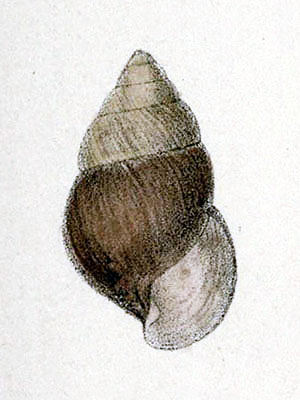
(public domain)
*********************
edited: 15.06.2020
Carelia bicolor (Jay)
Two-colored Carelia Snail (Carelia bicolor)
The Two-colored Carelia Snail was described in 1839; the species was restricted to an area in the Hanakāpī’ai Valley in the northern north-west of Kaua’i, Hawaiian Islands.
The shells of this species reach heights of nearly 4 cm; they are quite variably colored and patterned; some of the color forms were originally described as distinct varieties or subspecies.
The species disappeared sometimes after the 1930s.
***
syn. Carelia bicolor ssp. adusta Gould, Carelia bicolor ssp. fuliginea Pfeiffer, Carelia bicolor ssp. hyperleuca Pilsbry
*********************

(public domain)
*********************
References:
[1] George W. Tryon; Henry A. Pilsbry; a.o.: Manual of Conchology. Second series: Pulmonata. Vol 21: Achatinellidae (Amastrinae). 1911
[2] C. Montague Cooke Jr.: The land snail genus Carelia. Bishop Museum Bulletin 85: 1-97. 1931
*********************
edited: 24.01.2024
Amastra kauaiensis (Newcomb)
Kauai Amastra Snail (Amastra kauaiensis)
The Kauai Amastra Snail was described in 1860, as its name implies it was endemic to the island of Kaua’i, Hawaiian Islands.
The shells reached sizes of about 2,3 cm
***
The American conchologist William Harper Pease, who collected the species, gives a brief description of the life animal.:
“The animal is very small in comparison with the size and thickness of the shell, a little larger than the diameter of the latter, and excessively narrow. It drags the heavy shell balanced on its back. When it crawl the head is stretched out as far as possible, the tow ends of the body solidly fixed, until the middle part contracts and draws the shell forward.“
*********************
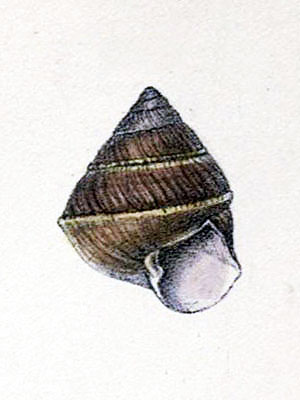
(public domain)
*********************
edited: 15.06.2020
Leptachatina fossilis Cooke in Hyatt & Pilsbry
Fossil Leptachatina Snail (Leptachatina fossilis)
As its name implies, the Fossil Leptachatina Snail from the island of Kaua’I, Hawaiian Islands was already extinct when it was described in 1911.:
“The shell is umbilicate, conically ovate, white (in a fossil state) ….” [1]
***
The shell was very small, reaching a height of only about 0,7 cm. The Fossil Leptachatina Snail very likely was among the first snail species to disappear after the arrival of men.
*********************
References:
[1] George W. Tryon; Henry A. Pilsbry; a.o.: Manual of Conchology. Second series: Pulmonata. Vol 21: Achatinellidae (Amastrinae). 1911
*********************
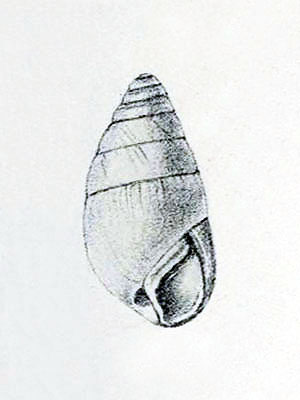
(public domain)
*********************
edited: 31.03.2018
Leptachatina nitida (Newcomb)
Shining Leptachatina Snail (Leptachatina nitida)
The Shining Leptachatina Snail was described in 1853, it was endemic to the island of Maui, where it apparently was restricted to at least two populations at Kula and Ulapalakua on the western slopes of the Haleakala volcano in the eastern part of the island.
The shells reached lengths of about 0,8 to 1 cm. [1]
***
There are several specimens, apparently originating from the islands of Moloka’i and O’ahu, that are sometimes assigned to this species, very probably erroneously. [1]
*********************
References:
[1] George W. Tryon; Henry A. Pilsbry; a.o.: Manual of Conchology. Second series: Pulmonata. Vol 21: Achatinellidae (Amastrinae). 1911
*********************

(public domain)
*********************
edited: 31.03.2018
Carelia cumingiana ssp. cumingiana (Pfeiffer)
Cuming’s Carelia Snail (Carelia cumingiana ssp. cumingiana)
Cuming’s Carelia Snail was described in 1855; the exact origin of this form is not known, but it is believed that it came from the Lumaha’i valley near the northern coast of Kaua’i, Hawaiian Islands.
The shells of this form reach heights of 3.7 to 4.8 cm.
“… the original forest which was probably occupied by this species was destroyed by fire or cattle many years ago. Since most of the species of Carelia occupy rather restricted colonies, I feel certain that the typical form of this species must be considered extinct. From the close similarity of the specimens, I feel sure that all came from a restricted colony and that at the time they were collected they were fairly abundant.” [2]
*********************

(public domain)
*********************
References:
[1] George W. Tryon; Henry A. Pilsbry; a.o.: Manual of Conchology. Second series: Pulmonata. Vol 21: Achatinellidae (Amastrinae). 1911
[2] C. Montague Cooke Jr.: The land snail genus Carelia. Bishop Museum Bulletin 85: 1-97. 1931
*********************
edited: 24.01.2024
Carelia olivacea ssp. baldwini Cooke
Baldwin’s Olive Carelia Snail (Carelia olivacea ssp. baldwini)
Baldwin’s Olive Carelia Snail was described in 1931; it inhabited an unknown region in northern Kaua’i, Hawaiian Islands.
“The original series of this species consists of two very closely agreeing specimens. One of these was undoubtedly alive when collected, while the other had been dead but a short time.” [1]
“At first glance this subspecies appears to eb more closely allied to C. cochlea than to C. olivacea. Its size, outlines, short columella, and proportionately small aperture certainly show a strong resemblance to the former species. In the form and surface texture of its embryonic whorls and in the texture of the surface of its last two whorls, it proves to be more closely allied to C. olivacea. It may represent a hybrid form between these two very distinct species or, less probably a very aberrant type of olivacea.” [1]
*********************
References:
[1] C. Montague Cooke Jr.: The land snail genus Carelia. Bishop Museum Bulletin 85: 1-97. 1931
*********************
edited: 25.01.2024
Amastra rugulosa ssp. rugulosa Pease
Rugulose Amastra Snail (Amastra rugulosa ssp. rugulosa)
This species was described in 1870.
The Rugulose Amastra Snail was endemic to the Kawaihau and Lihue Districts in eastern Kaua’i, Hawaiian Islands.
***
The species may be split into five subspecies, which are or are not valid, these are.:
Amastra rugulosa ssp. annosa Cooke
Amastra rugulosa ssp. fastigata Cooke
Amastra rugulosa ssp. janeae Cooke
Amastra rugulosa ssp. normalis Cooke
Amastra rugulosa ssp. rugulosa Pease
***
The species, which was quite abundant in former times, appears to have declined already in pre-European times. [1]
*********************
References:
[1] David A. Burney; Helen F. James; Lida Pigott Burney; Storrs L. Olson; William Kikuchi; Warren L. Wagner; Mara Burney; Deirdre McCloskey; Delores Kikuchi, Frederick V. Grady, Reginald Gage II; Robert Nishek: Fossil evidence for a diverse biota from Kaua’i and its transformation since human arrival. Ecological Monographs 7(14): 615-641. 2001
*********************

http://www.inaturalist.org/people/pliffgrieff
(under creative commons license (4.0))
http://creativecommons.org/licenses/by-nc-sa/4.0
*********************
edited: 20.04.2019
Amastra subrostrata (Pfeiffer)
Subrostrate Amastra Snail (Amastra subrostrata)
This species was described in 1859, it was found on the island of O’ahu, however, an exact locality has apparently not been recorded.
The shell reached a size of about 1,5 cm.
This species may be a somewhat elongated form of the White-lipped Amastra Snail (Amastra albolabris (Newcomb)).
*********************
edited: 30.09.2017
Leptachatina obsoleta (Pfeiffer)
Obsolete Leptachatina Snail (Leptachatina obsoeta)
The Obsolete Leptachatina Snail was described in 1856; it is known to have inhabited the crater of the Haleakalā volcano on the island of Maui, Hawaiian Islands, where it was found at an elevation of nearly 2440 m “rather abundant under stones near “Crystal Cave” on the almost barren floor of the crater.” [1]
“Only seventeen adult specimens were gathered, three of which have a remarkable development. Near the base of the columella is a low blunt spiral callus on the perietal wall and extending into the aperture. This may be a senile character, though two of the specimens do not show any signs of senility. This thickening has not been observed in any other species.” [1]
The shells reach a height of about 0.8 cm; they are thin, very faintly striated, glossy pale corneous, the outer lip and the columella are edged with dark brown.
*********************

(public domain)
*********************
References:
[1] George W. Tryon; Henry A. Pilsbry; a.o.: Manual of Conchology. Second series: Pulmonata. Vol 21: Achatinellidae (Amastrinae). 1911
*********************
edited: 15.01.2024
Amastra juddii Cooke
Judd’s Amastra Snail was described in 1917; it was endemic to the island of Kaua’i, Hawaiian Islands.
The shells reached sizes of about 1,15 cm in height.
“This species is represented by the single type specimen in the collection of the Bishop Museum and two or three additional specimens in the Judd collection. It is entirely unlike any other species of Cyclamastra from Kauai. Its nearest relative appears to be A. umbilicata from Oahu. From this species it is most easily distinguished by its flatter whorls, greater proportional width, and broad aperture.” [1]
*********************
References:
[1] C. Montague Cooke: Some new species of Amastra. Bishop Museum Occasional Papers 3(3): 1-34. 1917
*********************

Photo from: ‘C. Montague Cooke: Some new species of Amastra. Bishop Museum Occasional Papers 3(3): 1-34. 1917’
(public domain)
*********************
edited: 04.05.2022
Amastra subsoror Hyatt & Pilsbry
Lahaina Amastra Snail (Amastra subsoror)
The last life specimens were recorded sometimes before 1945 in the Wahikuli Gulch near the city of Lahaina on the western coast of Maui, Hawaiian Islands.
The species was last seen in 1946.
*********************

(public domain)
*********************
edited: 30.09.2017
Amastra whitei Cooke
White’s Amastra Snail was described in 1917; it was found near the western coast of Hawai’i, Hawaiian Islands.
The shells reach average sizes of 1,2 cm in height.
“At first sight this Amastra appears to be a form of A. conica. It differs, however, from A. conica and its varieties … in its thicker shell, closed perforation, besides the embryonic whorls are slightly more convex and the apex less pointed. Some of the specimens are more distinctly keeled at the periphery than the holotype. It is, however, in the immature specimens that the differences are more apparent. The shells are broader in proportion to their length and there is a strong distinct keel at the periphery.” [1]
*********************
References:
[1] C. Montague Cooke: Some new species of Amastra. Bishop Museum Occasional Papers 3(3): 1-34. 1917
*********************

Photo from: ‘C. Montague Cooke: Some new species of Amastra. Bishop Museum Occasional Papers 3(3): 1-34. 1917’
(public domain)
*********************
edited: 04.05.2022
Amastra montana Baldwin
The Montane Amastra Snail was described in 1906; it inhabited the forest floors at elevations above 1800 m on the slopes of Pu’u Kukui, a mountain on western Maui, Hawaiian Islands, it shared its habitat with another now extinct amastrid snail, Alexanders Laminella Snail (Laminella alexandri (Newcomb)).
There is also a little description of the animal itself.:
“Animal in motion as long as the shell. Mantle dark-brown with a light-brown border. Foot and tentacles almost black. Head above coarsely granulated.” [1]
*********************
References:
[1] George W. Tryon; Henry A. Pilsbry; a. o.: Manual of Conchology. Second series: Pulmonata. Vol 21: Achatinellidae (Amastrinae). 1911
*********************

Depiction from: ‘George W. Tryon; Henry A. Pilsbry; a. o.: Manual of Conchology. Second series: Pulmonata. Vol 21: Achatinellidae (Amastrinae). 1911’
(public domain)
*********************
edited: 16.05.2022
Carelia lymani Cooke
Lyman’s Carelia Snail (Carelia lymani)
This species was described in 1931 based on a single [?] subfossil specimen.
The species was certainly endemic to the island of Kaua’i, Hawaiian Islands, as most of its other congeners; the exact location, however, is not known, the specimen was found in a private collection in a tray together with specimens of Pilsbry’s Carelia Snail (Carelia pilsbryi Sykes).
The single known shell is about 4,5 cm high. [1]
*********************
References:
[1] C. Montague Cooke Jr.: The land snail genus Carelia. Bishop Museum Bulletin 85: 1-97. 1931
*********************
edited: 21.10.2017
Amastra elongata (Newcomb)
Elongated Amastra Snail (Amastra elongata)
This appears to be a somewhat questionable species, its description in the ‘ Manual of Conchology’ reads as follows.:
“Three specimens are no. 29960 of the Newcomb collection, Cornell University. One of these may be the type which was said to be unique, but none agrees exactly with Newcomb’s measurements. It is a shell having the color and texture of A. subsoror, with which it agrees in the long, convex embryonic whorl. the surface may be a little rougher. It differs from subsoros in the decidedly more elongate shape and consequently smaller aperture. It differs from A. perversa by the longer, more convex embryonic whorls. Seems to be a valid species, close to those of Maui and Molokai.” [1]
*********************
References:
[1] George W. Tryon; Henry A. Pilsbry; a.o.: Manual of Conchology. Second series: Pulmonata. Vol. 23: Appendix to Amastridae. Tornatellinidae. Index, vols. XXI-XXIII. 1915-1916
*********************
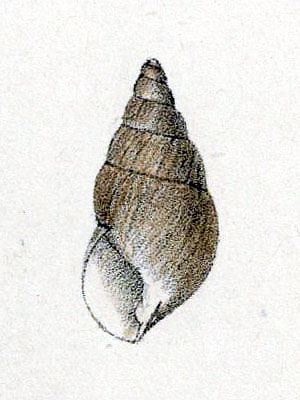
(public domain)
*********************
edited: 15.06.2020
Carelia turricula (Mighels)
Towered Carelia Snail (Carelia turricula)
This species was described in 1845.
The Towered Carelia Snail was endemic to the island of Kaua’i, Hawaiian Islands, where it was restricted to a small area around the Hanalei Bay on the northern shore of the island.
The species was last found in 1953, however, only empty shells were found at that date.
***
The Towered Carelia Snail was the largest species of its genus and the largest of all land snails of the Hawaiian Islands. Its shells reached sizes of up to 8,5 cm, they were bright yellow to dark chestnut, with the base being darker, nearly chocolate brown.
There is also a form, named as Carelia turricula var. newcombi Pfeiffer, whose shells are chestnut-colored with a pale-yellow belt below the peripheral angle and a black base. It is in fact most likely just a color morph. Another form, named as Carelia turricula var obeliscus Reeve, differs somewhat in the sculpture of the shell, it is also not accepted as being distinct.
*********************
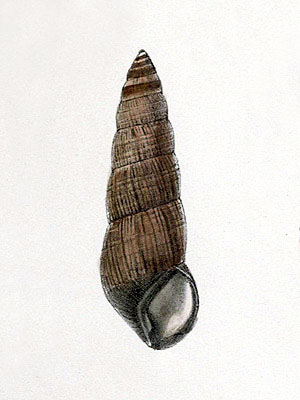
(public domain)
*********************
edited: 21.10.2017
Carelia tenebrosa Cooke
Gloomy Carelia Snail (Carelia tenebrosa)
The Gloomy Carelia Snail was described in 1931; it inhabited the slopes of Mt. Ha’upu near the northern coast of Kaua’i, Hawaiian Islands.
The species was still alive when described but probably already on the brink of extinction.:
“Carelia. Conditions damp. Very scarce and difficult to find alive. Well concealed under mass of dead leaves and rubbish.” [1]
*********************
References:
[1] C. Montague Cooke Jr.: The land snail genus Carelia. Bishop Museum Bulletin 85: 1-97. 1931
*********************
edited: 25.01.2024
Amastra cyclostoma Baldwin
Circle-mouthed Amastra Snail (Amastra cyclostoma)
This species was described in 1895 when it was already restricted to a tiny relict population inhabiting an area of only about 10 m².
Charles M. Cooke Jr., an American malacologist who described many endemic Hawaiian gastropod taxa, wrote at 11. April 1899.:
“… It has been found in only one place, under a few orange trees. A circle with radius of six feet [ca. 1,8 m] would enclose the whole space in which they have been found.”
***
The Circle-mouthed Amastra Snail was endemic to the coastal regions of Kaumakani [formerly known as Makaweli] at the southwestern coast of Kaua’i, Hawaiian Islands.
The species’ author made some remarks concerning the animal in life.:
“Animal when extended in motion .95 inches [ca. 2,4 cm] in length; posterior portion of foot tapering and very short, front portion long; head elongated, ocular and labial tentacles widely separated. Mantle dingy-white with streaks of black. Foot very light brown, superior portion and sides thickly studded with regular, dark brown granulations. Tentacles long, dark brown.”
The shell reached a size of about 1,68 cm.
*********************
References:
[1] David A. Burney; Helen F. James; Lida Pigott Burney; Storrs L. Olson; William Kikuchi; Warren L. Wagner; Mara Burney; Deirdre McCloskey; Delores Kikuchi, Frederick V. Grady, Reginald Gage II; Robert Nishek: Fossil evidence for a diverse biota from Kaua’i and its transformation since human arrival. Ecological Monographs 7(14): 615-641. 2001
*********************

(public domain)
*********************
edited: 30.09.2017
Amastra mirabilis Cooke
The Glorious Amastra Snail was described in 1917; it was endemic to the island of Maui, Hawaiian Islands.
The shell of the holotype has a size of 1,45 cm in height; “In its dead state the last two whorls are white, becoming darker above, the apical whorls being of a dark reddish-brown. In two specimens there are traces of a thin dark greenish-brown epidermis.” [1]
The species was apparently already extinct when it was described, as only empty shells were found.
*********************
References:
[1] C. Montague Cooke: Some new species of Amastra. Bishop Museum Occasional Papers 3(3): 1-34. 1917
*********************
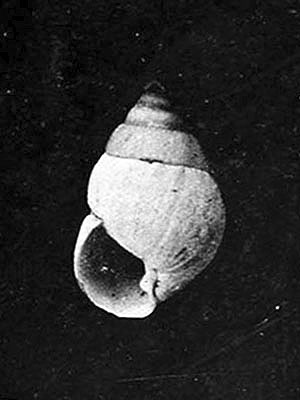
Depiction from: ‘C. Montague Cooke: Some new species of Amastra. Bishop Museum Occasional Papers 3(3): 1-34. 1917’
(public domain)
*********************
edited: 16.05.2022
Amastra hitchcocki Cooke
Hitchcock’s Amastra Snail was described in 1917; it was apparently restricted to a region near the northern shore of Moloka’i, Hawaiian Islands.
“The original specimen of this species was collected by Mr. D. H. Hitchcock, in May, 1913 and consisted of the aperture and a portion of the last whorl. On four trips to Molokai, the writer tried to relocate the original fossil bed but was unsuccessful. In December, 1914, Mr. G. P. Cooke, found a number of examples at Hinanaulua on the northern coast of Molokai. Unfortunately, the only whole specimen was not quite mature. During March, 1915, the writer spent about three weeks on Molokai, collecting for the most part from the fossil beds of the northern coast from the northwest point of the island to near Puukapele. A number of broken and immature specimens were taken and in addition to these two fine adults. One of these serves as a type of the species and came from the second valley west of Puukapele.” [1]
The shells of this species are unusually large and reach sizes of up to 3 cm in height.
*********************
References:
[1] C. Montague Cooke: Some new species of Amastra. Bishop Museum Occasional Papers 3(3): 1-34. 1917
*********************

Photo from: ‘C. Montague Cooke: Some new species of Amastra. Bishop Museum Occasional Papers 3(3): 1-34. 1917’
(public domain)
*********************
edited: 04.05.2022
Amastra globosa Cooke
Globose Amastra Snail (Amastra globosa)
The Globose Amastra Snail was described in 1933.
Unfortunately I could not find any further information about this species so far.
*********************
edited: 15.06.2020
Amastra assimilis (Newcomb)
West Maui Amastra Snail (Amastra assimilis)
This species was described in 1853, it is endemic to the western part of the island of Maui in the Hawai’i Islands, where it occurred at several localities.
The shells appear to be quite variable. [1]
*********************
References:
[1] George W. Tryon; Henry A. Pilsbry; a.o.: Manual of Conchology. Second series: Pulmonata. Vol 21: Achatinellidae (Amastrinae). 1911
*********************

(public domain)
*********************
edited: 15.06.2020
Carelia mirabilis Cooke
Wonderful Carelia Snail (Carelia mirabilis)
The Wonderful Carelia Snail was described in 1931 on the basis of 17 subfossil specimens, of which only a single one, apparently a juvenile one, was at least nearly complete; they were recovered from a limestone cliff near the Maha’ulepu beach in the south-east of Kaua’i, Hawaiian Islands.
The shells must have reached heights of about 4.5 to 4.8 cm. [1]
This species, being restricted to the lowland, very likely disappeared shortly after the arrival of the first Polynesian settlers.
*********************
References:
[1] C. Montague Cooke Jr.: The land snail genus Carelia. Bishop Museum Bulletin 85: 1-97. 1931
*********************
edited: 24.01.2024
Leptachatina subcylindracea Cooke
Subcylindric Leptachatina Snail (Leptachatina subcylindracea)
The Subcylindric Leptachatina Snail was described in 1911, it is known only from subfossil specimens found on the island of O’ahu, Hawaiian Islands, where it appeares to have been quite widespread. [1]
This was a coastal respectively lowland species and thus disappeared shortly after the arrival of the first Polynesian settlers.
***
The species has also been reported from Kaho’olawe and Moloka’i, however, this may be an error. [1]
*********************
References:
[1] Patrick V. Kirch; Carl C. Christensen: Nonemarine molluscs and paleoecology at Barber’s Point, O’ahu. Prepared for Archaeological Research Center Hawaii, Inc.. Department of Anthropology; Bernice P. Bishop Museum 1-40. 1980
*********************
edited: 22.04.2019
Amastra irwiniana Cooke
Irwin’s Amastra Snail (Amastra irwiniana)
Irwin’s Amastra Snail was described in 1908, it was restricted to the summit of Pu’u Lanihuli in the Ko’olau Range of O’ahu, Hawaiian Islands
The shells reach sizes of about 1,12 cm in length and 0,59 cm in diameter, the upper whorls and the base of the last whorl were light brown with a slightly yellowish tinge, the upper portion of the last whorl was dark chestnut. [1]
*********************
References:
[1] C. Montague Cooke Jr.: Three new species of Amastra from Oahu. Bishop Museum Occasional Papers 3(2): 213-216. 1908
*********************

(public domain)
*********************
edited: 07.10.2020
Amastra flavescens ssp. emortua Cooke
This form was described in 1917; it is known from (sub)fossil remains that were recovered from deposits of the Huehue (flow?) on the north-western slopes of the Hualālai Volcano in northern Kona on the island of Hawai’i, Hawaiian Islands.
The shells reach average sizes of 1,8 cm in heigth.
*********************
References:
[1] C. Montague Cooke: Some new species of Amastra. Bishop Museum Occasional Papers 3(3): 1-34. 1917
*********************

Photo from: ‘C. Montague Cooke: Some new species of Amastra. Bishop Museum Occasional Papers 3(3): 1-34. 1917’
(public domain)
*********************
edited: 04.05.2022
Leptachatina sp. ‘West Maui’
West Maui Leptachatina Snail (Leptachatina sp.)
This is an undescribed species that is known from about six populations, both on eastern and western Maui, Hawaiian Islands.
The species was recorded in the 1940s and 1960s from the Hanaula-iki- and Iao Valleys, from the Wahikuli Gulch and from other places; the last record dates to 1971, when only a single population was left.
The West Maui Leptachatina Snail was a ground-dwelling species that was found in leaf litter, it is certainly extinct like most other members of this genus.
*********************
edited: 08.10.2017
Amastra albolabris (Newcomb)
White-lipped Amastra Snail (Amastra albolabris)
This species was described in 1853, it was restricted to the Wai’anae Mountains in western O’ahu, Hawaiian Islands, where it appears to have been quite common and widespread.
The shells reached sizes of about 1,3 to 1,6 cm.
The White-lipped Amastra Snail is now considered extinct, like most of its congeners.
*********************
References:
[1] Robert H. Cowie; Claire Régnier; Benoît Fontaine; Philippe Bouchet. Measuring the Sixth Extinction: what do mollusks tell us? The Nautilus 131(1): 3-41. 2017
*********************

(public domain)
*********************
edited: 27.09.2017
Carelia cochlea (Reeve)
Screwed Carelia Snail (Carelia cochlea)
This species was described in 1849, it is known exclusively from subfossil specimens.
The shells reached sizes of about 4 cm. [1]
***
The Screwed Carelia Snail died out shortly after the colonization of the Hawaiian Islands by the first Polynesian settlers, which introduced rats and pigs to the islands.
*********************
References:
[1] C. Montague Cooke Jr.: The land snail genus Carelia. Bishop Museum Bulletin 85: 1-97. 1931
*********************

(public domain)
*********************
edited: 21.10.2017
Amastra thurstoni Cooke
Thurston’s Amastra Snail was described in 1917; it was found in Late Pleistocene/Early Holocene deposits at Manoa in the south-east of O’ahu, Hawaiian Islands.
The shells of this species reached sizes of about 1,4 cm in height.
“This extremely rare and interesting species is entirely distinc [sic] from any other species of Amastra. The Pleistocene deposits in Manoa are rather interesting as the shells do not occur in layers as in most deposits but in rather small pockets, containing from a few cc. to maybe half a liter. These pockets are literally full of shells, mostly in fragments, and belong to a number of genera.
A. thurstoni differs from all the other species of Cyclamastra by its proportionately long and slender spire and distinct plicate surface. It is not closely related to A. fragilis of Molokai, with which it agrees in having a narrow perforation and attenuated spire. It differs, however, in having more whorls, the spire is proportionately more attenuate and the surface more distinctly plicate.” [1]
*********************
References:
[1] C. Montague Cooke: Some new species of Amastra. Bishop Museum Occasional Papers 3(3): 1-34. 1917
*********************
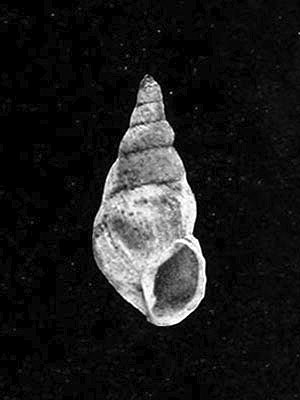
Photo from: ‘C. Montague Cooke: Some new species of Amastra. Bishop Museum Occasional Papers 3(3): 1-34. 1917’
(public domain)
*********************
edited: 04.05.2022
Amastra sinistrorsa Baldwin
This species was described in 1906; it is apparently known only from subfossil specimens that were recovered from Holocene deposits in Mana in the Hāmākua District near the north-eastern coast of the island of Hawai’i, Hawaiian Islands.
The shells reach sizes of about 1,4 cm in height.
*********************

Depiction from: ‘George W. Tryon; Henry A. Pilsbry; a. o.: Manual of Conchology. Second series: Pulmonata. Vol 21: Achatinellidae (Amastrinae). 1911’
(public domain)
*********************
edited: 12.08.2022
Amastra spaldingi Cooke
Spalding’s Amastra Snail was described in 1908, it was restricted to the summit of the Pu’u Konahuanui Peak on the island of O’ahu, Hawaiian Islands
***
This species should not to be confused with Spalding’s Planamastra Snail (Planamastra spaldingi Cooke).
*********************
References:
[1] C. Montague Cooke Jr.: Three new species of Amastra from Oahu. Bishop Museum Occasional Papers 3(2): 213-216. 1908
[2] George W. Tryon; Henry A. Pilsbry; a.o.: Manual of Conchology.
*********************
edited: 28.09.2020
Amastra extincta (Pfeiffer)
Extinct Amastra Snail (Amastra extincta)
The Extinct Amastra Snail was scientifically named for the fact that it was already extinct for a long time when it was described in 1855.
The species is known exclusively from subfossil specimen collected somewhere on the island of O’ahu, Hawaiian Islands.
… from the original description.:
“Shell perforate, ovate-turrite, solid, striatulate, chalky. Spire long, tapering upwards, acute. Whorls 7, scarcely convex, the last less than one-third the total length, somewhat compressed around the perforation. Aperture slightly oblique, rhombic-oval, angular at the base. Columellar fold compressed, ascending almost from the base. Peristome simple, unexpanded, the margins joined by a thick, somewhat nodiferous callus, columellar margin dilated, free.” [1]
The shells reached sizes of about 1,6 cm in length. [1]
*********************
References:
[1] George W. Tryon; Henry A. Pilsbry; a.o.: Manual of Conchology. Second series: Pulmonata. Vol 21: Achatinellidae (Amastrinae). 1911
*********************

(public domain)
*********************
edited: 27.09.2020
Leptachatina leiahiensis Cooke
Leiahi Leptachatina Snail (Leptachatina leiahiensis)
The Leiahi Leptachatina Snail was described in 1911; it is known from subfossil shells that were found at Lē’ahi (Diamond Head) in the south-eastern part of O’ahu, Hawaiian Islands.
“This species is distinct from all the other species. The turrited blunt spire is very characteristic of this species as is also the oblique aperture. I know of no species with which it may be closely related. It is extremely rare. Less than a dozen specimens were obtained in four trips, two of which were made especially for this species. Of all the specimens collected, only two are now unbroken, and only four were intact when collected, as the shells are very delicate and easily broken in cleaning.” [1]
*********************

(public domain)
*********************
References:
[1] George W. Tryon; Henry A. Pilsbry; a.o.: Manual of Conchology. Second series: Pulmonata. Vol 21: Achatinellidae (Amastrinae). 1911
*********************
edited: 15.01.2024
Amastra davisiana Cooke
Konahuanui Amastra Snail (Amastra davisiana)
This species was described in 1901.
The species was apparently endemic to the summit of the Pu’u Konahuanui, a mountain in the Ko’olau Range on the island of O’ahu, Hawaiian Islands.
The shells reached sizes of about 1,44 to 1,65 cm.
The Konahuanui Amastra Snail is now considered extinct.
*********************

(public domain)
*********************
edited: 30.09.2017
Amastra knudseni Baldwin
Knudsen’s Amastra Snail was described in 1895, the species was restricted to a small remnant of native forest at Pu’u ka Pele in the Waimea Canyon area of the island of Kaua’i, Hawaiian Islands.
The author who described the species also mentions some little information about its whereabouts … and the obvious reasons for its extinction.:
“The species is very rare. We dedicate it to Mr. Knudsen, the young naturalist who discovered it. He writes that it is of very limited distribution, being found far up the mountain only in an isolated tract of woodland which escaped the forest fires of twenty years ago. In three days’ diligent search he found only twelve living examples.”
***
The species was quite large, its shells reached sizes of about 3,3 cm in length.
*********************
edited: 24.04.2019
Planamastra spaldingi ssp. koolauensis Cooke
Koolau Planamastra Snail (Planamastra spaldingi ssp. koolauensis)
The Koolau Planamastra Snail is known from fossil or subfossil remains that were recovered from deposits at Kahuku and Punalu’u near the northeastern coast of O’ahu, Hawaiian Islands, which can be dated to Pleistocene to probably Early Holocene age. [1]
This form may indeed be the ancestor of the form that is now considered the nominate form of the smae species: Spalding’s Planamastra Snail (Planamastra spaldingi ssp. spaldingi Cooke).
*********************
References:
[1] C. Montague Cooke: New species of Amastridae. Bishop Museum Occasional Papers 10(6): 1-29. 1933
*********************
edited: 26.09.2020
Carelia dolei ssp. dolei Ancey
Dole’s Carelia Snail (Carelia dolei ssp. dolei)
The nominate race of this species was described in the year 1893, as far as I know, this form is known exclusively from subfossil shells.
The species was endemic to Kaua’i, Hawaiian Islands.
The shell reaches a height of about 5,8 cm.
*********************
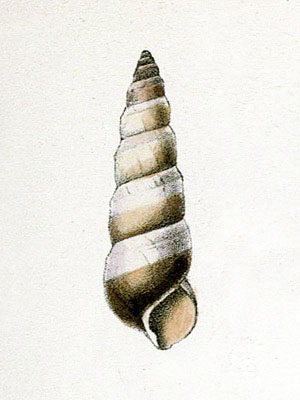
(public domain)
*********************
edited: 21.10.2017
Amastra luctuosa ssp. sulphurea Ancey
Sulphur-colored Amastra Snail (Amastra luctuosa ssp. sulphurea)
The Sulphur-colored Amastra Snail is a subspecies of the Mournful Amastra Snail (Amastra luctuosa (Pfeiffer)) and occurred in the vicinity of that form, in some valleys along the northern shore of O’ahu, Hawaiian Islands.
The shells reached sizes of about 1,55 cm in height and 0,95 cm in diameter. [1]
*********************
References:
[1] George W. Tryon; Henry A. Pilsbry; a.o.: Manual of Conchology. Second series: Pulmonata. Vol 21: Achatinellidae (Amastrinae). 1911
*********************
edited: 06.10.2020
Amastra dwightii Cooke
Dwight’s Amastra Snail (Amastra dwightii)
Dwight’s Amastra Snail was described in 1933, it was endemic to the island of O’ahu, Hawaiian Islands.
There appears to be no further information about this species except for that it is considered extinct.
*********************
edited: 07.05.2019
Leptachatina defuncta Cooke
Defunct Leptachatina Snail (Leptachatina defuncta)
The Defunct Leptachatina Snail, described in 1910, is apparently known only based on (sub)fossil shells which were found at a place named Mana, probably in the northeastern part of Hawai’i, Hawaiian Islands.
The species appears to have been rather variable, its shells reached sizes of about 0,9 cm in length. [1]
*********************
References:
[1] George W. Tryon; Henry A. Pilsbry; a.o.: Manual of Conchology. Second series: Pulmonata. Vol 21: Achatinellidae (Amastrinae). 1911’
*********************
Depiction from: ‘George W. Tryon; Henry A. Pilsbry; a.o.: Manual of Conchology. Second series: Pulmonata. Vol 21: Achatinellidae (Amastrinae). 1911’
(public domain)
*********************
edited: 17.04.2019
Amastra anthonii ssp. remota Cooke
The Remote Amastra Snail was described in 1917, originally as a full species; it is known from (sub)fossil remains that were recovered from Pleistocene deposits in the southwestern part of the Kalalau Valley on the island of Kaua’i in the Hawaiian Islands.
“A. remota is undoubtedly closely related to A. anthoni. It differs from Newcomb’s species by its much larger and flatter embryonic whorls, more cylindrical and less conic outlines. There is no doubt that both species are derived from the same stock as the granular surfaces of both are almost identical though slightly coarser in the best preserved specimens of A. remota. in two specimens of this species, the aperture is very oblique and narrow, the last whorl descending very rapidly just before terminating at the peristome.” [1]
It was classified as a subspecies of Anthoni’s Amastra Snail (Amastra anthonii (Newcomb)) in 1933. [2]
***
This form might in fact not be distinct at all but may be identical with Anthoni’s Amastra Snail.
*********************
References:
[1] C. Montague Cooke: Some new species of Amastra. Bishop Museum Occasional Papers 3(3): 1-34. 1917
[2] C. Montague Cooke: New species of Amastridae. Bishop Museum Occasional Papers 10(6): 1-29. 1933
*********************
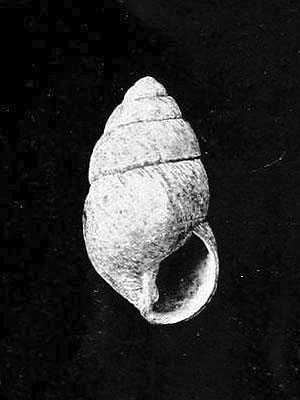
Photo from: ‘C. Montague Cooke: Some new species of Amastra. Bishop Museum Occasional Papers 3(3): 1-34. 1917’
(public domain)
*********************
edited: 04.05.2022
